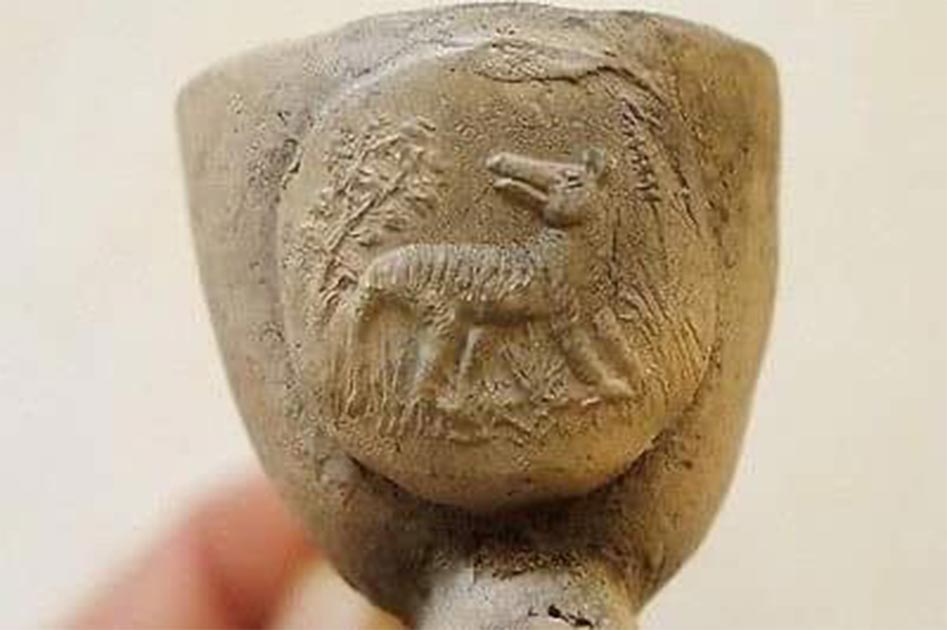Tiger Design Pipe is ‘Holy Grail’ of Tasmanian Archaeology
A rare 200-year-old clay pipe depicting a Tasmanian tiger is being called the “holy grail” of Tasmanian archaeology.
Discovered in a bottle dump in Launceston, in the north of Tasmania, Australia, buried amongst smashed bottles dated to around 1830, the old pipe is decorated with one of the earliest recorded European depictions of a ( Thylacinus cynocephalus) (or Tasmanian tiger) and this is the “holy grail” of Tasmanian archaeology according to Australian archaeologists speaking with ABC News.
Created about 190 years ago from molded river clay, the pipe not only depicts a Tasmanian tiger but also a kookaburra which was not introduced to Tasmania until 1902. According to Darren Watton, the Principal archaeologist with Southern Archaeology, the discovery is a “very exciting find” and he added that he could barely contain himself when he learned of the artifact’s existence.
Finding The “Holy Grail” In A 200-Year-Old Bottle Dump
Clay pipes were the preferred nicotine delivery system used before cigarettes were mass produced in the 19th century and pipes were made with one time use molds which were discarded after a pipe had been made. In terms of Tasmanian archaeology, this pipe “is the holy grail” because it has a range of special archaeological qualities.
The pipe was excavated in 2016 by an amateur bottle digger who discovered it lodged between two larger bottles at the base of a rubbish pit on a private Launceston property. Stephen Sleightholme, from the International Thylacine Specimen Database (ITSD), bought the pipe at auction and alerted Mr Watton a few months later and the archaeologist said, “There's quite a buzz in the archaeology and academic community about this particular pipe,” because it conjures up all these sorts of ideas about where it was made and who might have made it?

The clay pipe was found intact, which is uncommon. (Image: Darren Watton)
The Scientific Quest Into Extinct Tasmanian Tiger
The ITSD was first published as an electronic resource on a series of three CD-ROMs in April 2005 after a four-year long research project digitally photographed and categorized all known material evidence of the now extinct Tasmanian tiger within museum, university, and private collections. At the 2005 Whitley Awards Professor Mike Archer, Dean of Science at the University of New South Wales said the ITSD was completely revised in May 2009 and released on a single DVD totaling some “3.68 GB of data and images.”
The bowl of the 200-year-old pipe is decorated with the distinctive striped coat of a Tasmanian tiger, but it doesn’t appear to relate to any 19th century image that could have been used to assist in the modelling, Dr Sleightholme said. Concluding that the somewhat naïve artwork “appears to be original” he said it was “the earliest depiction” of a thylacine on record. Furthermore, the scientist said “the mystery deepens” when the motif of the kookaburra is considered as this bird species was not found in Tasmania until 1902, suggesting the maker had at some time visited the mainland. But other archaeologists think the bird might be a Tasmanian kingfisher, or that it’s a generic bird symbol.
- Were the works of Shakespeare inspired by Cannabis? Scientists find traces of drugs on pipes
- 17 Out-of-Place Artifacts Said to Suggest High-Tech Prehistoric Civilizations Existed
- Savoring the Danger: Romans Loved Toxic 'Sugar of Lead' Wine

Thylacinus cynocephalus, from Gould's The Mammals of Australia. (Henry Constantine Richter / Public Domain)
Put This in Yer Pipe and Smoke It
In November 2018, Helen Shield on ABC Radio Hobart reported on the bizarre discovery made by couple Liz and Rob Virtue who manage Glen Derwent estate, a 200-year-old Georgian farmhouse at New Norfolk west of Hobart. While clearing out the attic, hidden between two bricks, a tobacco pipe had been deposited “to ward off evil spirits.” In an ABC.AU News article historian Ian Evans of the Tasmanian Magic Research Project, which records evidence of 19th century magic in Tasmania, said the pipe was “part of a superstitious ritual,” an idea supported in the discovery of coins beneath the house's floorboards earlier this year which the historian said were “part of an evil-averting custom.”
Talking about the Virtues' pipe the historian said “I thought it was very clearly a deliberate concealment of an artefact, the purpose of which is to divert unpleasant spiritual beings from the humans in the house to these objects. If these beings could be lured into voids in a building, they would not be able to escape and therefore not be able to harm the humans who lived there.” This makes one wonder if the Tasmanian tiger design on the recently discovered 200-year-old pipe might two have been imbued with supernatural powers?
Top image: The pipe decorated with the image of the extinct Tasmanian Tiger. Source: Darren Watton / ABC News
By Ashley Cowie



















